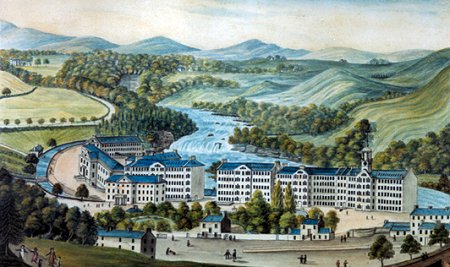New Lanark

New Lanark was previously owned by David dale and Richard Arkwright, who were Englishman already famous for industrializing cotton spinning south of the border. In 1786 David Dale took sole control and four mills in full operation. For his workforce he turned first to children. Out of a total workforce in 1793 of some 1,150, over 800 were children, many from the orphanages of Edinburgh and Glasgow. Their working day began at 6.00am and continued until 7.00pm.
On 1 January 1800, Robert Owen took over the management of David Dale's cotton mills at New Lanark and put into practice the ideas that he had developed earlier in his life and his workers at New Lanark were made to adopt new living, working, sanitary, educational and other standards. New Lanark had a population of 2,000 people, 500 of whom were young children from the poorhouses and charities of Edinburgh and Glasgow.
Over the following years Robert Owen gradually began to implement a series of ideas that at their time were revolutionary. In 1809 children were moved from dormitories to the purpose-built Nursery Buildings. The village store was opened by Owen in 1813. He built an Institution for the Formation of Character in 1816, and a year later he built his School for Children next door. Child labour was phased out to be replaced by a system of infant education. The Village Store went from strength to strength, with its profits being recycled to pay for the schooling. New Lanark gained international fame when Owen's experiments in enhancing his workers' environment resulted in increased productivity and profit. He was especially proud of the arrangement for marking each man's conduct daily by a ‘silent monitor,’ a label coloured to indicate either goodness and badness and placed opposite each man's post.


Comments
Post a Comment